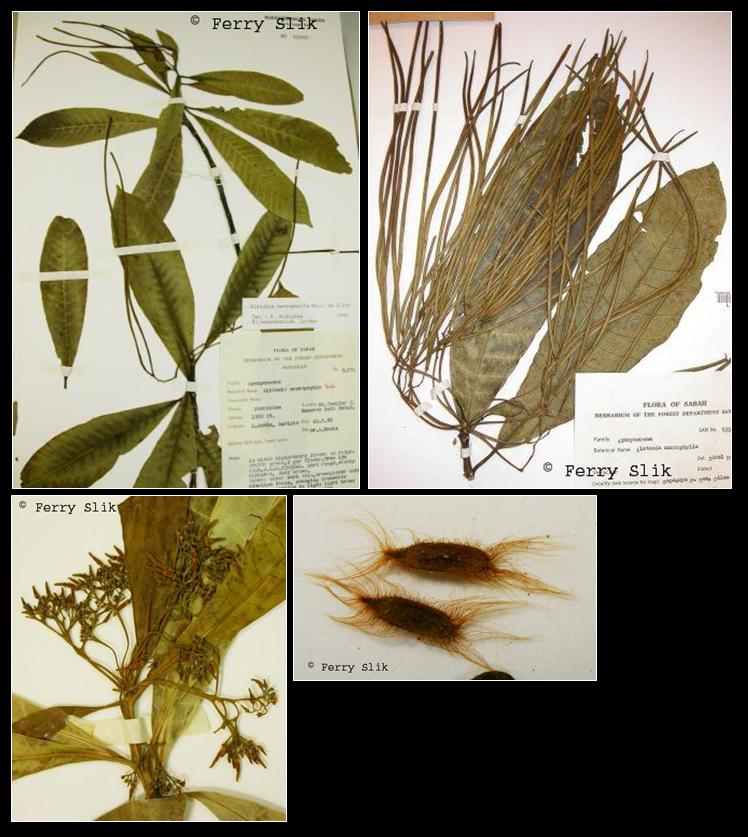Alstonia macrophylla Wall. ex G.Don., Gen. Syst. 4 (1837)
(Latin for 'large leaves')Synonyms
Alstonia acuminata Miq.
Alstonia batino Blanco
Alstonia brassii Monach.
Alstonia costata Wall. ex Miq. [illegitimate]
Alstonia glabriflora Markgr.
Alstonia macrophylla var. acuminata (Miq.) Monach.
Alstonia macrophylla var. glabra DC
Alstonia macrophylla var. mollis Merr.
Alstonia oblongifolia Merr.
Alstonia pangkorensis King & Gamble
Alstonia paucinervia Merr.
Alstonia subsessilis Miq.
Diagnostics
Tree with little white sap. Leaves in whorls of usually 4 leaves, lower surface greenish, secondary
veins placed farther apart than most species in the genus. Fruits very long and narrow, placed in pairs;
splitting open to expose many small seeds with two tufts of hairs for wind dispersal.
Description
A small to medium-sized tree up to 30(-50) m tall, bole straight, up to 100 cm in diameter,
sometimes fluted at the base or with small buttresses, outer bark blackish-brown to grey, smooth
or rough, minutely scaly, tuberculate, or fissured, inner bark cream, with broken, orange-yellow
laminations, without latex; leaves in whorls of 3-4, obovate or narrowly obovate, sometimes elliptical
to narrowly elliptical, 4.5-25(-32) cm x 1.5-10.5 cm, apex rounded to narrowly acuminate, with 12-25(-31)
pairs of secondary veins, petiole 2-25 mm long; inflorescence many-flowered, pedicel 1-4 mm long,
calyx laxly puberulous to glabrous, corolla glabrous outside; follicles glabrous, which are placed in pairs
and filled with many wind dispersed hairy seeds. [from PROSEA]
Ecology
Grows in a wide range of vegetation types and soils in primary and disturbed forest ranging from flooded
areas to montane forest, on soils ranging from sandy clay to limestone, from sea-level to about 2900 m
altitude. Quite often found near the coast, just behind mangrove forests, but also in mixed dipterocarp
forests. Usually on ridges and hillsides with sandy to clayey soils. Also growing on ultrabasic and
limestone soils.
Uses
In the Philippines, the bark in the form of powder, decoction, infusion, tincture or wine preparation
is used as a febrifuge, tonic, antiperiodic, antidysenteric, emmenagogue, anticholeric and a vulnerary.
In Thailand, the bark is used as a tonic, antiamoebic, emmenagogue and antimalarial. In the Central
Province (Papua New Guinea) a decoction of the young leaves is drunk to cure lung and ear congestions.
In the Oro (Northern) Province (Papua New Guinea) the scraped bark is mixed with water and drunk, as well
as used to wash the forehead, to relieve a headache. The wood is used as hard alstonia. Powdered bark
mixed with water is used against skin diseases.
Distribution
India and Sri Lanka, into Indochina, Nicobar Islands, Thailand, Peninsular Malaysia, Borneo, the
Philippines, Moluccas, and New Guinea. Cultivated in Africa.
Local names
Borneo: Bakau; Bundu-bundu; Mangalang; Pulai daun besar; Sarakad; Sayongan; Tunjang pipit.
English: Hard alstonia, hard milkwood (En).
Indonesia: pule batu (Ambon), kai riti (Seram), ai oi (Biak).
Malaysia: pulai penipu bukit (Peninsular), pulai daun besar, sayongan (Sabah).
Papua New Guinea: ai wawoi (Papua), andelagar (Enga), dero (Madang).
Philippines: batino (Tagalog, Bikol, Pangasinan), kuyau-kuyau (Bikol), itang-itang (Panay Bisaya).
Thailand: thungfa, kra thungfa hai, teen thian (peninsular).
Vietnam: s[uwx]a l[as] l[ows]n, m[ows]p l[as] to.
